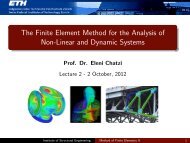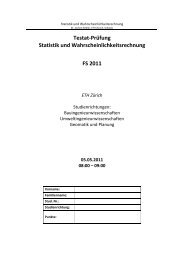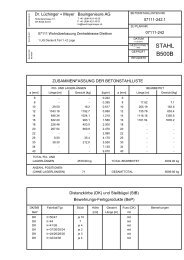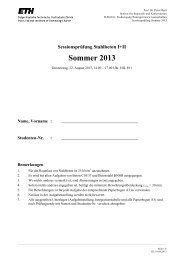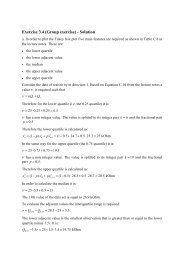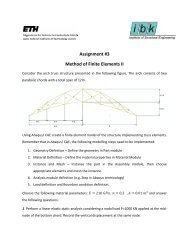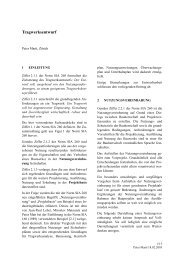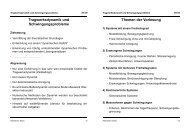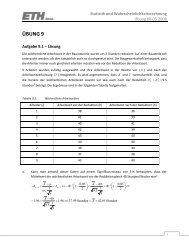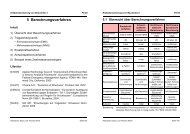A New Program for the Design of Cable-Stayed Bridges Summary 1 ...
A New Program for the Design of Cable-Stayed Bridges Summary 1 ...
A New Program for the Design of Cable-Stayed Bridges Summary 1 ...
Create successful ePaper yourself
Turn your PDF publications into a flip-book with our unique Google optimized e-Paper software.
A <strong>New</strong> <strong>Program</strong> <strong>for</strong> <strong>the</strong> <strong>Design</strong> <strong>of</strong> <strong>Cable</strong>-<strong>Stayed</strong> <strong>Bridges</strong><br />
Edoardo<br />
ANDERHEGGEN<br />
Pr<strong>of</strong>essor<br />
Swiss Federal Institute <strong>of</strong><br />
Technology (ETH)<br />
Zurich, Switzerland<br />
Edoardo Anderheggen has been<br />
Pr<strong>of</strong>essor <strong>of</strong> Computational<br />
Methods in Engineering since<br />
1976 at <strong>the</strong> ETH.<br />
Pietro PEDROZZI<br />
Civil Engineer<br />
Swiss Federal Institute <strong>of</strong><br />
Technology (ETH)<br />
Zurich, Switzerland<br />
Pietro Pedrozzi, born 1975,<br />
graduated in civil engineering in<br />
1999 at <strong>the</strong> ETH and is now<br />
working at his Ph.D. <strong>the</strong>sis at<br />
Pr<strong>of</strong>. Anderheggen’s institute.<br />
<strong>Summary</strong><br />
A new finite element program has been developed which allows to easily simulate all construction<br />
stages <strong>of</strong> a cable-stayed bridge taking construction history dependent phenomena such as locked-in<br />
displacements, creep and shrinkage into account. The program also automatically computes all<br />
needed pre-camber values and <strong>the</strong> cables post-tensionings. It can also be used during <strong>the</strong> bridge<br />
erection to correct unexpected deviations from <strong>the</strong> planned geometry.<br />
Keywords: <strong>Cable</strong>-stayed bridges; construction history; pre-camber; post-tensioning; locked-in<br />
displacements; creep; shrinkage; user friendliness.<br />
1. Introduction<br />
In cable-stayed bridges <strong>the</strong> deck is supported at more or less regular distances by cables which are<br />
fixed to <strong>the</strong> top or along a mast protruding from <strong>the</strong> deck plane. In most cases cable-stayed bridges<br />
are self-anchored, i.e. <strong>the</strong> normal <strong>for</strong>ce introduced in <strong>the</strong> deck by <strong>the</strong> cables on one mast's side is<br />
compensated by <strong>the</strong> normal <strong>for</strong>ce introduced on <strong>the</strong> o<strong>the</strong>r side.<br />
The main advantages <strong>of</strong> cable-stayed bridges are that <strong>the</strong>y can be built in very large spans (today<br />
with a central span <strong>of</strong> up to 1000 meters) by free cantilevering (see figure 1), <strong>of</strong>fer a great stiffness,<br />
need little material and can look quite<br />
elegant.<br />
Despite <strong>the</strong>se advantages, cable-stayed<br />
bridges began being diffused only in<br />
<strong>the</strong> fifties because it was impossible to<br />
analyze <strong>the</strong>m with a reasonable ef<strong>for</strong>t<br />
and a satisfactory accuracy using <strong>the</strong><br />
manual methods <strong>of</strong> <strong>the</strong> pre-computer<br />
days.<br />
The reason why <strong>the</strong> design and<br />
Fig. 1 Bridge erection by free cantilevering<br />
erection <strong>of</strong> cable-stayed bridges is so<br />
computationally intensive is that <strong>the</strong>y<br />
are statically over-determined to a degree which is approximatively as large as <strong>the</strong> number <strong>of</strong> cables<br />
and, at <strong>the</strong> same time that <strong>the</strong>ir displacements and section <strong>for</strong>ces are adjustable through <strong>the</strong> posttensioning<br />
<strong>of</strong> each single cable.<br />
In addition, long span cable-stayed bridges underlay non-linear phenomena such as cable sag and<br />
concrete creep.<br />
The goal <strong>of</strong> adjusting <strong>the</strong> post-tensioning <strong>for</strong>ce in each cable and <strong>of</strong> mounting pre-cambered mast<br />
and deck segments is that <strong>of</strong> having a finished structure which reflects <strong>the</strong> planned geometry. Even<br />
though cable-stayed bridges are globally very stiff, single members can be quite flexible and<br />
produce large displacements, especially during construction.
Once statical analysis <strong>for</strong> several construction stages and <strong>for</strong> <strong>the</strong> final service state has been carried<br />
out, computations might still be needed during erection in combination with measurements in situ<br />
so as to correct alignment errors and to keep <strong>the</strong> ra<strong>the</strong>r unpredictable behaviour <strong>of</strong> concrete and<br />
supports under close control.<br />
2. Use <strong>of</strong> standard structural analysis s<strong>of</strong>tware<br />
<strong>Cable</strong>-stayed bridges can, in principle be successfully analyzed with standard structural analysis<br />
s<strong>of</strong>tware. This is however not straight<strong>for</strong>ward. Standard s<strong>of</strong>tware, in general, cannot automatically<br />
find <strong>the</strong> post-tensioning <strong>for</strong>ces needed in <strong>the</strong> cable-stays or <strong>the</strong> pre-camber values <strong>for</strong> <strong>the</strong> mast and<br />
deck segments. In many cases <strong>the</strong>se still have to be found by <strong>the</strong> bridge designer by means <strong>of</strong> time<br />
consuming and error prone manual computation. Here <strong>the</strong>re are a few possible strategies:<br />
• Insertion <strong>of</strong> fictitious hinges in <strong>the</strong> mast so as to find cable <strong>for</strong>ces with which <strong>the</strong> mast is not<br />
submitted to bending moments.<br />
• Use <strong>of</strong> very high artificial stiffnesses <strong>for</strong> <strong>the</strong> normal <strong>for</strong>ce, to avoid axial displacements in<br />
<strong>the</strong> deck and <strong>the</strong> pylons.<br />
• Use <strong>of</strong> supports instead <strong>of</strong> cables to retrieve <strong>the</strong> post-tensioning <strong>for</strong>ces from <strong>the</strong> support<br />
reactions.<br />
• Determination <strong>of</strong> <strong>the</strong> bridge's displaced shape caused by a unitary shortening <strong>of</strong> every cable<br />
and a unitary pre-camber value <strong>for</strong> every deck and mast segment. Formulation <strong>of</strong> an<br />
equation system (to be solved in an extern program) representing as many compatibility<br />
conditions as unitary shortenings and pre-camber values, allowing to find <strong>the</strong> actually<br />
needed shortenings and pre-camber values (this is <strong>the</strong> method adopted in our program<br />
BRIDE but implemented in a totally automatic way).<br />
These computations, when per<strong>for</strong>med ei<strong>the</strong>r manually or using additional external programs, are<br />
very time consuming and inhibit <strong>the</strong> investigation <strong>of</strong> several project variants.<br />
3. The program BRIDE and its peculiarities<br />
The difficulties encountered in <strong>the</strong> analysis <strong>of</strong> cable-stayed bridges with standard s<strong>of</strong>tware and <strong>the</strong><br />
opportunity <strong>of</strong>fered by <strong>the</strong> technical progress in computer hard- and s<strong>of</strong>tware appeared to be two<br />
good reasons to start <strong>the</strong> development <strong>of</strong> a computer program specially tailored on <strong>the</strong> requirements<br />
<strong>of</strong> cable-stayed bridge designers.<br />
The fact that a growing number <strong>of</strong> programs <strong>for</strong> <strong>the</strong> analysis <strong>of</strong> cable stayed bridges is being <strong>of</strong>fered<br />
shows that times are mature <strong>for</strong> fundamental research on this topic: this can provide a knowledge<br />
base <strong>for</strong> fur<strong>the</strong>r research on technically newly accessible domains, asses commercially available<br />
programs or as a seed development <strong>for</strong> new commercial products.<br />
The program has been called "BRIDE", an acronym <strong>for</strong> BRIdge DEsigner (it is a tradition <strong>of</strong> our<br />
institute to give programs romantic names), and its goal is to help <strong>the</strong> designer in <strong>the</strong> following<br />
tasks:<br />
• model all kinds <strong>of</strong> cable-stayed bridges, taking all main non linear effects into account in a<br />
consistent way,<br />
• easily allow <strong>the</strong> analysis <strong>of</strong> each construction stage,<br />
• find all needed post-tensioning <strong>for</strong>ces <strong>for</strong> <strong>the</strong> cables and all pre-camber values <strong>for</strong> <strong>the</strong> mast<br />
and deck segments in a fully automatic way and<br />
• correct deviations in <strong>the</strong> geometry measured in situ by changing <strong>the</strong> cable <strong>for</strong>ces.<br />
Five main ideas determined <strong>the</strong> design <strong>of</strong> <strong>the</strong> program BRIDE and distinguish it from o<strong>the</strong>rs<br />
programs:<br />
• As <strong>the</strong> displacements are assumed to be small, which is acceptable being cable-stayed<br />
bridges very stiff, <strong>the</strong> behaviour <strong>of</strong> every structure's segment modelled with a finite element<br />
can be fully described with <strong>the</strong> element's local stiffness matrix plus a set <strong>of</strong> "initial"
displacements. Such an element does not depend on <strong>the</strong> global structure and, fully<br />
representing <strong>the</strong> physics <strong>of</strong> <strong>the</strong> modelled structure's segment, can be added to or removed<br />
from <strong>the</strong> numerical model just like <strong>the</strong> corresponding structure's segment can be added or<br />
removed in real life (see section 4).<br />
• Post-tensioning <strong>for</strong>ces or pre-camber values which have to be found automatically by <strong>the</strong><br />
program can be <strong>for</strong>mulated as initial element displacements whose magnitudes are found<br />
through conditions to be fulfilled (see section 5).<br />
• The erection <strong>of</strong> a cable-stayed bridge is an evolutionary process and <strong>the</strong> simplest way to<br />
describe it with accuracy is a list <strong>of</strong> <strong>the</strong> changes occurring in <strong>the</strong> system in chronological<br />
order (a "chronological" objects list, see section 6).<br />
• In order to take displacements locked in concrete and creep into account it is necessary to<br />
know <strong>the</strong> displacements <strong>of</strong> <strong>the</strong> structure in <strong>the</strong> stages prior to <strong>the</strong> stage being analyzed (see<br />
section 7).<br />
• The program BRIDE should be user friendly enough to be applicable both in <strong>the</strong> bridge<br />
construction industry and <strong>for</strong> teaching purposes.<br />
4. Element description through its local stiffness matrix and a set <strong>of</strong> initial<br />
displacements<br />
The geometry <strong>of</strong> space frame finite element models such as those analyzed by <strong>the</strong> program BRIDE<br />
is described through <strong>the</strong> Cartesian coordinates <strong>of</strong> <strong>the</strong> nodes and through <strong>the</strong> element's incidence<br />
nodes. In addition, every element requires section and material properties. Once <strong>the</strong> Cartesian<br />
coordinates <strong>of</strong> <strong>the</strong> incidence nodes, <strong>the</strong> material and <strong>the</strong> section <strong>of</strong> <strong>the</strong> element are defined, its<br />
elastic response can be <strong>for</strong>mulated by means <strong>of</strong> a local 12x12 elastic stiffness matrix.<br />
If we would consider an existing bridge already modelled in a simulation program (see figure 2),<br />
take a concrete cutter, cut out a<br />
segment <strong>of</strong> <strong>the</strong> structure modelled with<br />
a single finite element (see figure 3)<br />
and determine its geometry in <strong>the</strong><br />
unloaded state, we would notice that<br />
its geometry does not correspond to<br />
<strong>the</strong> geometry <strong>of</strong> <strong>the</strong> finite element. In<br />
fact, displacements “locked-in” during<br />
<strong>the</strong> hardening <strong>of</strong> <strong>the</strong> concrete, creep,<br />
Fig. 2 Step 1. Consider an element in <strong>the</strong> numeric<br />
model <strong>of</strong> an existing bridge<br />
Fig. 3 Step 2. Cut out a structure segment<br />
corresponding to a finite element <strong>of</strong> an existing bridge<br />
considered as a "conditional" load, see section 5).<br />
shrinkage and <strong>the</strong> pre-camber would<br />
have slightly changed <strong>the</strong> shape <strong>of</strong> <strong>the</strong><br />
cut out, thus unloaded segment (see<br />
figure 4).<br />
The vector a initial <strong>of</strong> size 12 (3<br />
translation and 3 rotation components<br />
<strong>for</strong> each incidence node) containing<br />
<strong>the</strong> difference between <strong>the</strong> cut out<br />
segment's and <strong>the</strong> finite element's<br />
geometry can be <strong>for</strong>mulated as follows:<br />
a initial = a h + a cr + a sh (1)<br />
where a h is <strong>the</strong> contribution <strong>of</strong> <strong>the</strong><br />
concrete locked-in displacements, a cr<br />
that <strong>of</strong> creep and a sh is that <strong>of</strong><br />
shrinkage (<strong>the</strong> pre-camber is not taken<br />
into account here because it is<br />
One way to model <strong>the</strong> cut segment correctly is to reproduce its displacements by submitting <strong>the</strong><br />
finite element to a set <strong>of</strong> initial self-equilibrating <strong>for</strong>ces f (see figure 5) producing <strong>the</strong> initial
Fig. 4 Step 3. The geometry <strong>of</strong> <strong>the</strong> structure segment cut<br />
out and <strong>the</strong> geometry <strong>of</strong> <strong>the</strong> finite element used to<br />
model it differ by <strong>the</strong> initial displacements a initial<br />
Fig. 5 Step 4. The finite element submitted to <strong>the</strong> initial<br />
self-equilibrating <strong>for</strong>ce f assumes <strong>the</strong> same geometry as<br />
<strong>the</strong> structure segment cut out<br />
Fig. 6 Section idealization used <strong>for</strong> composite beam<br />
elements<br />
displacements a initial . The <strong>for</strong>ces f are<br />
found by multiplying <strong>the</strong> element local<br />
stiffness matrix k with a initial :<br />
f = k . a initial (2)<br />
The components <strong>of</strong> <strong>the</strong> vector f, like<br />
<strong>for</strong> any kind <strong>of</strong> element load, are to be<br />
assembled in <strong>the</strong> global load vector<br />
every time <strong>the</strong> element is part <strong>of</strong> <strong>the</strong><br />
model, its local stiffness matrix k<br />
being assembled in <strong>the</strong> global stiffness<br />
matrix.<br />
Being initial, i.e. corresponding to a<br />
de<strong>for</strong>med but stress-free state, <strong>the</strong><br />
contribution from f to <strong>the</strong> section<br />
<strong>for</strong>ces has to be ignored during post<br />
processing, i.e. <strong>the</strong> section <strong>for</strong>ces<br />
induced by f in <strong>the</strong> element have to be<br />
subtracted from <strong>the</strong> section <strong>for</strong>ces<br />
found from <strong>the</strong> nodal displacements <strong>of</strong><br />
<strong>the</strong> global solution. This subtraction<br />
does not affect <strong>the</strong> equilibrium in <strong>the</strong><br />
structure because f is self-equilibrating:<br />
this is a property <strong>of</strong> local stiffness<br />
matrices which, being singular, always<br />
deliver self-equilibrating <strong>for</strong>ces group<br />
if multiplied with any nodal<br />
displacement vector.<br />
Initial displacements have to be taken<br />
into account in a slightly different way<br />
<strong>for</strong> <strong>the</strong> composite beam element<br />
specially developed <strong>for</strong> <strong>the</strong> program<br />
BRIDE, which allows to take <strong>the</strong> bond<br />
between concrete and its underlying<br />
steel pr<strong>of</strong>ile into account (see figure 6).<br />
The composite beam element takes<br />
bond into account by merging into a<br />
single combined section <strong>the</strong> section <strong>of</strong><br />
<strong>the</strong> cast concrete and <strong>the</strong> section <strong>of</strong> <strong>the</strong><br />
steel pr<strong>of</strong>ile, which is modelled with a<br />
so-called <strong>for</strong>mwork element. For<br />
composite beam elements f is found as<br />
follows:<br />
f = k co . a co h – q fo co + k ca . (a ca cr + a ca sh ) + k fo . (a fo cr + a fo sh ) (3)<br />
where k co is <strong>the</strong> stiffness matrix computed with <strong>the</strong> combined section, a co h and q fo co are <strong>the</strong><br />
displacements and <strong>the</strong> nodal <strong>for</strong>ces <strong>of</strong> <strong>the</strong> <strong>for</strong>mwork beam during <strong>the</strong> casting stage, k ca and k fo are<br />
<strong>the</strong> stiffness matrices <strong>of</strong> <strong>the</strong> cast concrete part and <strong>of</strong> <strong>the</strong> <strong>for</strong>mwork beam, respectively, with no<br />
bond between <strong>the</strong>m. a ca cr , a ca sh , a fo cr and a fo sh are <strong>the</strong> initial displacements <strong>for</strong> <strong>the</strong> <strong>for</strong>mwork beam<br />
and <strong>for</strong> <strong>the</strong> cast concrete beam (it is justified to have also initial displacements due to creep and<br />
shrinkage <strong>for</strong> <strong>the</strong> <strong>for</strong>mwork since this might be in pre-cast concrete). All this <strong>for</strong>ces, stiffness<br />
matrices and displacements are expressed relatively to <strong>the</strong> centroid <strong>of</strong> <strong>the</strong> combined section. The<br />
element is <strong>the</strong>n excentrically connected to its nodes.<br />
The fact <strong>of</strong> not taking bond into account <strong>for</strong> k ca and k fo is a conspicuous simplification which is<br />
acceptable because <strong>the</strong> self-equilibrating load f is applied on <strong>the</strong> un-displaced composite element<br />
(whose stiffness takes bond into account) hence differences between <strong>the</strong> initial displacements <strong>of</strong> <strong>the</strong><br />
cast concrete a cr ca + a sh ca and those <strong>of</strong> <strong>the</strong> <strong>for</strong>mwork a cr fo + a sh fo lead just to differences in <strong>the</strong> section
<strong>for</strong>ces but not to bond producing discontinuities in <strong>the</strong> total strain (<strong>the</strong> elastic and <strong>the</strong> initial strain<br />
summed toge<strong>the</strong>r) because in <strong>the</strong> finite element model <strong>the</strong> element is “<strong>for</strong>ced” in its un-displaced<br />
shape <strong>for</strong> <strong>the</strong> <strong>for</strong>mulation <strong>of</strong> global equilibrium conditions <strong>the</strong> elastic strain must compensate any<br />
initial strain.<br />
5. Conditional loads<br />
Fig. 7 Snapshot <strong>of</strong> <strong>the</strong> program BRIDE showing <strong>the</strong><br />
deflected shape <strong>of</strong> a model in which <strong>the</strong> cables have not<br />
been post-tensioned<br />
The so-called conditional loads<br />
represent <strong>the</strong> post-tensioning <strong>of</strong> <strong>the</strong><br />
cable-stays and <strong>the</strong> pre-camber <strong>of</strong> mast<br />
and deck segments. Their intensities<br />
are automatically computed by <strong>the</strong><br />
program BRIDE.<br />
Both conditional loads and regular<br />
loads are model objects to be inserted<br />
in <strong>the</strong> chronological objects list (see<br />
section 6). The only differences is that<br />
in regular loads <strong>the</strong> load intensity is<br />
explicitly defined while in conditional<br />
loads it is defined through a condition<br />
to be fulfilled, and that conditional<br />
loads always belong to <strong>the</strong> standard<br />
load case load_history (see section 7).<br />
Their needed intensities are found<br />
automatically by <strong>the</strong> program BRIDE<br />
by fulfilling appropriate conditions<br />
specified by <strong>the</strong> program user (e.g.<br />
"post-tension a cable with such a <strong>for</strong>ce<br />
that its anchoring point on <strong>the</strong> deck<br />
has no vertical displacement in <strong>the</strong> last<br />
construction stage, taking into account<br />
<strong>the</strong> dead load and all o<strong>the</strong>r conditional<br />
loads", see figures 7 and 8).<br />
Fig. 8 Snapshot <strong>of</strong> <strong>the</strong> program BRIDE showing <strong>the</strong><br />
deflected shape <strong>of</strong> <strong>the</strong> same model as in figure 8 but<br />
post-tensioned with automatically found intensities<br />
6. Chronological objects list: a full description <strong>of</strong> <strong>the</strong> erection process<br />
After some attempts it became clear that <strong>the</strong> most convenient way to specify <strong>the</strong> evolving model <strong>of</strong><br />
a cable-stayed bridge during construction is a list <strong>of</strong> all model's objects (nodes, elements, supports,<br />
<strong>for</strong>ces, ...) ordered in <strong>the</strong> same chronological order in which <strong>the</strong>ir real counterparts are added to <strong>the</strong><br />
bridge being constructed. The object "stage" has been introduced to allow <strong>the</strong> program user to<br />
define a new construction stage whenever he feels that enough model objects have been added to<br />
<strong>the</strong> model since <strong>the</strong> last stage object. The stage objects define <strong>the</strong> states <strong>of</strong> <strong>the</strong> bridge where analysis<br />
is possible.<br />
Once <strong>the</strong> program BRIDE has read <strong>the</strong> objects list defined by <strong>the</strong> user, it constructs a list <strong>of</strong> data<br />
objects representing it.<br />
To build <strong>the</strong> numerical model <strong>of</strong> any construction stage, <strong>the</strong> (“object-oriented”) program BRIDE<br />
goes through <strong>the</strong> list <strong>of</strong> data objects from its beginning, sends to each data object <strong>the</strong> signal to<br />
assemble himself to <strong>the</strong> actual model and stops when it encounters <strong>the</strong> data object corresponding to
Fig. 9 Flow diagram <strong>of</strong> <strong>the</strong> assembling <strong>of</strong> a construction<br />
stage<br />
<strong>the</strong> desired construction stage (see<br />
figure 9).<br />
To analyze <strong>the</strong> model <strong>for</strong> a given<br />
load case <strong>the</strong> program BRIDE<br />
proceeds in an analogous way as<br />
<strong>for</strong> <strong>the</strong> assembling <strong>of</strong> <strong>the</strong> finite<br />
element model: it goes through <strong>the</strong><br />
chronological objects list from <strong>the</strong><br />
beginning, takes into account <strong>the</strong><br />
load objects belonging to <strong>the</strong><br />
chosen load case and stops when<br />
<strong>the</strong> stage object corresponding to<br />
<strong>the</strong> stage being analyzed is<br />
encountered.<br />
7. Hereditary iteration: an automatic analysis <strong>of</strong> each construction stage in<br />
chronological order<br />
To take creep and locked-in concrete displacements in a given construction stage into account it is<br />
necessary to know <strong>the</strong> initial displacements a cr and a sh <strong>for</strong> every element (see section 4), which, in<br />
turn, depend on <strong>the</strong> displaced shapes <strong>of</strong> <strong>the</strong> bridge in all previous construction stages. Since it is<br />
important to allow <strong>the</strong> user to view <strong>the</strong> results <strong>of</strong> any construction stage immediately, without<br />
having to wait <strong>for</strong> <strong>the</strong> analysis <strong>of</strong> all <strong>for</strong>mer stages, <strong>the</strong> nodal displacements <strong>of</strong> every construction<br />
stage due to all relevant loads are<br />
stored on <strong>the</strong> corresponding stage data<br />
object.<br />
Such nodal displacements are found<br />
during what is called “hereditary<br />
iteration”, in which every construction<br />
stage is automatically assembled and<br />
analyzed in chronological order.<br />
Figure 10 shows <strong>the</strong> flow diagram <strong>of</strong><br />
such iteration. To denote <strong>the</strong> load<br />
objects which should be taken into<br />
account during <strong>the</strong> hereditary iteration<br />
<strong>the</strong> standard load case called<br />
load_history has been introduced. The<br />
conditional loads are automatically<br />
assigned to this standard load case<br />
because <strong>the</strong>y are to be computed<br />
during <strong>the</strong> hereditary iteration. The<br />
user, however, is still free to assign<br />
Fig. 10 Flow diagram <strong>of</strong> <strong>the</strong> hereditary iteration <strong>the</strong>m to o<strong>the</strong>r load cases or load<br />
combinations.<br />
8. Conclusions<br />
The program BRIDE has been presented which allows to take <strong>the</strong> linear and non-linear behaviour <strong>of</strong><br />
cable-stayed bridges into account in a natural and accurate way during both initial design and<br />
construction. Different original approaches have been implemented in <strong>the</strong> program. The algorithms<br />
specially developed <strong>for</strong> <strong>the</strong> program BRIDE allowing to take such non-linear effects into account<br />
are briefly explained here.



